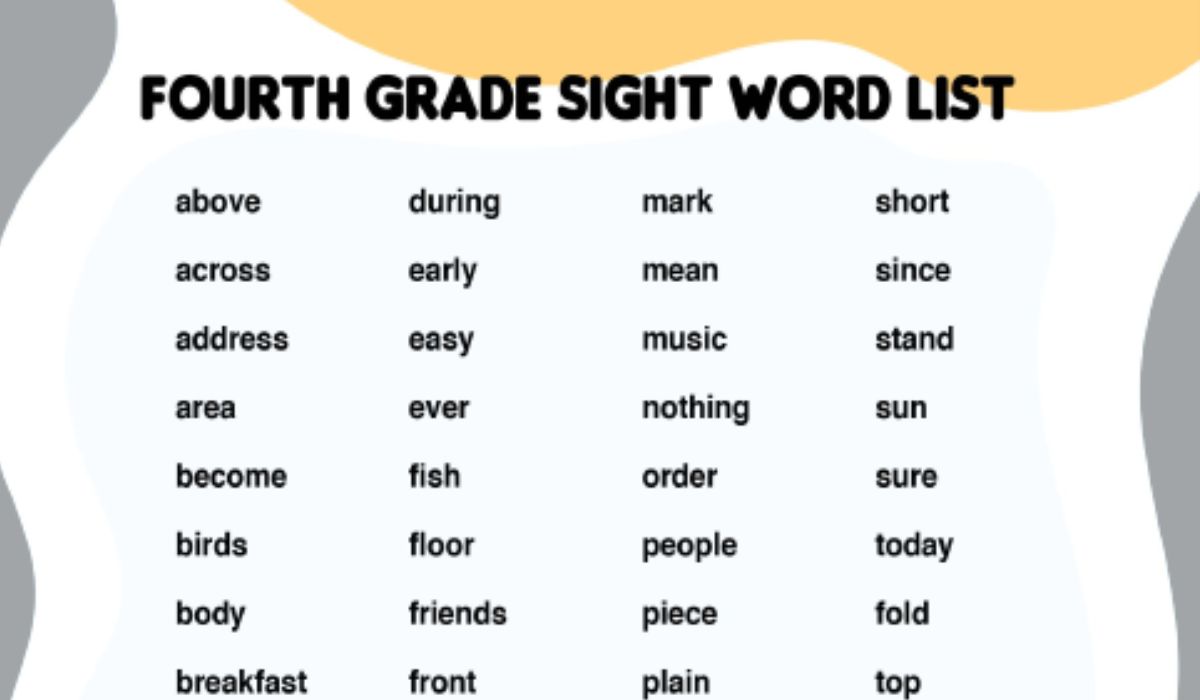There is a growing world of vocabulary for pupils to explore as sight words for 4th graders, they advance through school. While there are plenty of words that may be guessed simply by sounding them out, there is a separate category of words known as “sight words.” These are common words, although their pronunciations are not always predictable. Reading fluency and comprehension are greatly aided by students’ familiarity with common sight words because they appear frequently in literature. The purpose of this article is to help fourth graders improve their ability to recognize commonly used words by sight.
What are Sight Words?
Sight words, also known as high-frequency words or instant words, are common nouns and verbs seen in written texts. They frequently deviate from standard spelling patterns and grammar guidelines. Typical examples of sight words include “the,” “and,” “said,” “is,” and “are.” Because of their widespread use in printed works across a wide range of disciplines, these words have attained the status of core vocabulary.
Why are Sight Words Important?
Reading fluency and comprehension can’t be honed without first mastering sight words. Reading fluency and comprehension improve when pupils can read sight words automatically rather than having to decipher them letter by letter. Students can devote more mental energy to absorbing the text’s meaning and making connections between concepts if they don’t have to work as hard to read these words. Reading comprehension and fluency are both boosted by pupils’ ability to memorize and use commonly used sight words, opening up new worlds of knowledge to them.
Tips for Mastering Sight Words
Start with the Basics
It’s best to start with the most basic sight words. Make your own flashcards or use those found in online learning sites that provide engaging games and exercises. To find the most common sight words, many people look to lists like the Dolch Sight Word List and Fry’s Instant Words List.
Contextualize and Visualize
Assist pupils in grasping the significance of sight words by incorporating them into sentences and providing relevant examples. Inspire children to see the words in their minds or to create visual representations of the sight words for 4th graders, concepts. Word recognition and recall can be improved by the use of visual cues.
Practice with Repetition
The best way to learn sight words is through constant and regular practice. Use flashcards, word games, or other online or offline resources to practice sight words every day. If you want your students to stay interested and engaged in their studies, try a few different approaches.
Use Multisensory Approaches
To aid in learning to read by sight, it is helpful to use multimodal approaches. Instruct students to use their fingers or a stylus to trace or write the words. Take part in word games, word searches, and other activities that encourage reading aloud and writing down the sight words.
Integrate Technology
Take advantage of modern gadgets to make learning sight words a pleasurable experience for kids of all ages. Numerous educational applications and websites feature fun games and exercises meant to help students improve their sight word recognition. These tools can be customized to meet the unique requirements of each learner and provide instantaneous feedback on performance.
Create a Print-Rich Environment
Surround kids with print materials, both inside and outside of class. Put up interactive word walls, bulletin boards, or wall displays with common sight words. Inviting children to engage with these visual aids is a great way to help them better learn and remember sight words.
Read Widely
Encourage your pupils to read widely, exposing them to everything from fiction and nonfiction books to magazines and the web. Students can better retain and develop their vocabulary by reading on a consistent basis, where they are more likely to meet sight words in context.
Keep in mind that learning to read by sight is a process that calls for sight words for 4th graders, regular work and diligence. Inspire your kids by constantly praising and reinforcing their efforts. Fourth graders can set themselves up for lifelong reading success and have access to a wealth of information and inspiration by working hard to master sight word recognition.
Conclusion
In conclusion, fourth graders’ reading fluency and comprehension greatly benefit from the study of sight words. These high-frequency words are used often in written writings across a wide range of themes, while not always matching regular phonetic patterns. Students who have mastered sight words are better able to read fluently, comprehend language, and work with more advanced material.
For fourth graders to fully benefit from sight words, it is essential to review the fundamentals, provide context and visuals, and engage in extensive repetition. Sight word recognition can be improved by the use of multisensory methods, the incorporation of technology, and the creation of a print-rich environment. Students’ comprehension and vocabulary growth are both bolstered when they read widely from a range of literature.
Sight word fluency can be improved through participation in meaningful activities, reading independently, playing sight word games, and learning in groups. Successfully learning sight words requires a systematic approach that includes monitoring development, reviewing frequently, adding read-aloud sessions, and applauding accomplishments.
Fourth graders can establish a solid groundwork in sight word recognition through the use of these tactics and the cultivation of a conducive learning environment. They will develop a lifelong passion for reading and learning as they acquire the skills to read and comprehend a wide variety of materials.
Keep in mind that learning to read by sight is a process that takes time and demands a positive attitude. Fourth graders can set the stage for future academic achievement by applying themselves diligently and practicing what they learn. Let’s keep inspiring kids to read and giving them the tools they need to succeed as they explore the world of sight words.











